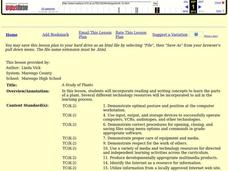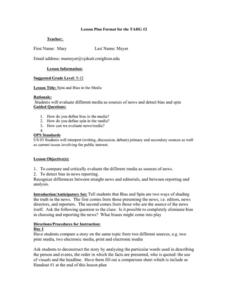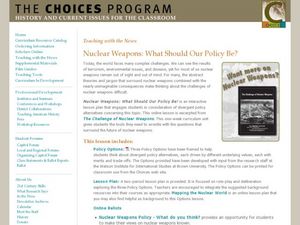PBS
What Makes A Good Video Report?
As part of a media literacy unit, class members establish criteria for good video reporting, and practice giving both positive (warm) and constructive (cool) criticism.
Curated OER
Cool Commercials Critique
High schoolers investigate advertising by critiquing commercials in class. In this media lesson, students view several commercials on their computers while completing a worksheet which helps them critique the ads. High schoolers define...
Curated OER
Critiquing A Speech Contestant
What makes a speech effective? Middle schoolers critique a speech for content and presentation. They view a video of a middle school student presenting an informational speech, They outline the content of the speech and critique the...
Curated OER
Abstraction-Critique of Art
Students apply a four step critique process as they observe and make personal decisions about abstract artworks.
Curated OER
Surviving AIDS
Enhance your middle and high schoolers' research skills with this lesson. After viewing a video clip about HIV and AIDS, high schoolers identify the facts and issues surrounding the disease. They work together to create a newspaper...
Curated OER
A Study of Plants
Using a variety of multi-media resources, your high schoolers become familiar with the parts of plant and create a story about plants using vocabulary learned during their research of plants. Completed stories are published using the...
Social Media Toolbox
Social Media Usage
Is there a difference in the way organizations present news via social media and in print? The third in a series of 16 lessons from The Social Media Toolbox explores news outlets and their delivery methods. Groups follow a story for a...
Curated OER
Children's Media and Censorship
High schoolers form opinions about children and television censorship after analyzing literature. They complete a journal writing activity to identify the topic and make a list of inappropriate television shows for children. Next, they...
Curated OER
AP Environmental Science-Food Fight
The content in this lesson is of a controversial nature. Please review to make sure it is suitable for your class. A video, The Meatrix is shown to the class, and then they discuss the emotionally-charged language that it uses. They are...
Google
Advanced 5: Evaluating Credibility of Sources
How do discerning readers determine bias and credibility? Ask small groups to figure it out! First, each group is provided with either articles or videos that contain bias. They examine the resources, respond to included questions, and...
Curated OER
Painting with and Learning From Art History - Extend the Composition
Students create a painting based on an artist from a chosen period in history. They research a modern artist and write a critique.
Curated OER
Sundials and Shadows - What Can They Teach Us About Seasons?
Students collect and analyze data relating to seasonal changes. They view a video, research web sites and build a sundial to collect their data.
Curated OER
School Facilities: Setting the Mood for Education
Students watch the News Ohio video about Lincoln Junior High School. They write a reaction paper, explaining what effect the studying environment has on students. If the classroom was in a basement, perhaps a little dark and damp, would...
Alabama Learning Exchange (ALEX)
Whales, Whales, Whales!
The title says it all! Help your pupils learn all about whales. Class members research different species of whales and share the information via video conferences with kids from another school. They conduct research on a selected species...
Curated OER
Spin and Bias in the Media
Students compare different types of media. In this media comparison lesson, students will assess the where all types of media gets its information by viewing a video of a news story and critiquing it.
Curated OER
Handling the Earth with Care
Eighth graders examine the characteristics of caring people. For this behavioral studies lesson, 8th graders differentiate between caring and uncaring personality traits. Students view a video about personality traits, and work in...
Curated OER
Superhighway Scholars
Students study the states of their choice by using Superhighway Scholars website. In this Unites States history lesson plan, students create a collage using information collected about a state of their choosing. This lesson plan provides...
Curated OER
Local Heroes
Students investigate heroes in their community by presenting a story of a true hero to their class. In this storytelling activity, students interview a local person who has performed a heroic deed and create a presentation with Windows...
Curated OER
Creating Our Newspapers
Students write newspaper articles in groups to form a class newspaper. In this newspaper lesson plan, students share their work with another group who critiques it.
Curated OER
THE FUGITIVE POETS
Learners, after viewing the video "Tell About the South," critique the section on the Fugitive Poets. They brainstorm why this unique group of poets might have formed and became so influential in the south. In addition, they focus on how...
Curated OER
Rave Reviews
A fun lesson that utilizes toys and persuasion! After reading the article, which was written in 2005, pull some advertisements for toys currently being sold. These will be more relevant to your middle and high schoolers. What toy is a...
Curated OER
Considering U.S. Policy
Students explore policies regarding environmental issues. In this global issues lesson, students research the linked Internet sources to investigate governmental policies to decrease environmental issues.
Curated OER
Nuclear Weapons: What Should Our Policy Be?
High schoolers investigate nuclear weapons policies. In this global issues instructional activity, students research policies that the United States could institute to control nuclear weapon production. High schoolers participate in a...
Curated OER
Sondheim: Voice of Cultural Change
Students explore Stephen Sondheim's contributions to musical theatre in the context of the dramatic cultural shift that occurred in American life in the late 1950s, 1960s, and 1970s.

























